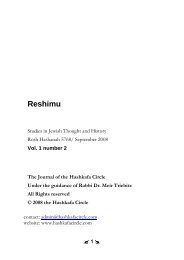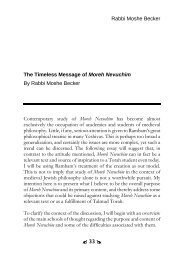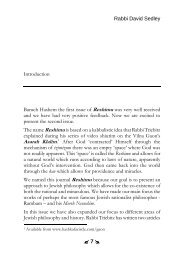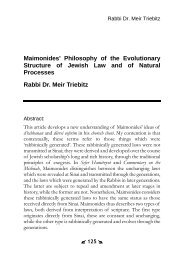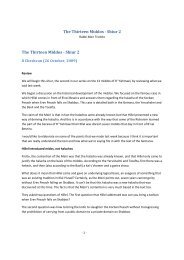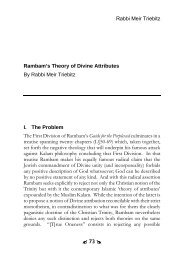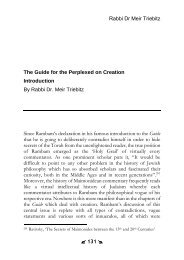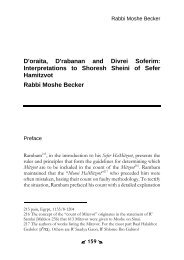Reshimu_3_journal_no.. - Hashkafa Circle
Reshimu_3_journal_no.. - Hashkafa Circle
Reshimu_3_journal_no.. - Hashkafa Circle
Create successful ePaper yourself
Turn your PDF publications into a flip-book with our unique Google optimized e-Paper software.
Rabbi Moshe Becker<br />
According to the schema presented by Graetz, Weiss, and others,<br />
whereby all 60 Tractates of the Talmud were covered in the bi-annual<br />
conventions of the academy over the course of 30 years, one needs to<br />
account for the missing sections of the Talmud. How is it that<br />
precisely those Tractates of the Talmud which are <strong>no</strong> longer relevant<br />
<strong>no</strong>wadays came to be missing from the Talmud? Most laws<br />
regarding agriculture are only applicable in Eretz Yisrael, and virtually<br />
all the laws of spiritual purity are relevant exclusively at times when<br />
the Temple is standing. According to Halevy’s understanding that R’<br />
Ashi commissioned the work on the Talmud as a special project, this<br />
is easily explained: it is quite conceivable that he chose to focus only<br />
on the sections of the Talmud that were still pertinent to daily life in<br />
Bavel. 55<br />
To support his position that R’ Ashi was leading a large group of<br />
scholars in this work, Halevy points out that in many instances in the<br />
Gemara, R’ Ashi is mentioned as a participant in a discussion,<br />
seemingly without rhyme or reason 56 . Often, in contexts in which R’<br />
Ashi had <strong>no</strong>t offered any opinion or been involved in any other way,<br />
we find Amoraim in the Gemara addressing R’ Ashi: “So-and-so said<br />
to R’ Ashi”, or “So-and-so asked R’ Ashi” 57 . This phe<strong>no</strong>me<strong>no</strong>n<br />
would make sense if, as the leader of the project, R’ Ashi conducted<br />
proceedings aimed at resolving difficulties or ruling between<br />
opinions. In such a setting, many of the Amoraim would be<br />
55 II, p. 524. The other historians, obviously aware of this difficulty, were forced<br />
to suggest that at some later point it was decided to remove the other Tractates or<br />
that the copiers stopped including these Tractates in their editions of the Talmud,<br />
perhaps due to lack of demand.<br />
56 II, from p. 562.<br />
57 Examples include: Kiddushin 6a, where Ravina attempts to resolve a question in<br />
the Gemara and addresses his remarks to R’ Ashi with <strong>no</strong> apparent connection;<br />
Yoma 32b where R’ Acha addresses his observation to R’ Ashi; similarly Menachot<br />
21b; Bava Batra 148b, and many others.<br />
27



